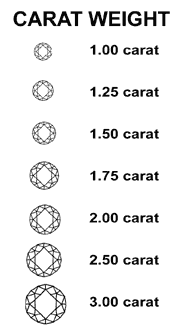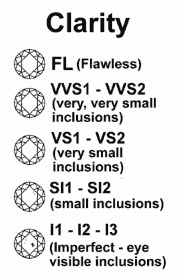|
Carat
 Carat refers to the weight of the diamond, but often confused with its “size.” One carat equals 200 milligrams. Carat refers to the weight of the diamond, but often confused with its “size.” One carat equals 200 milligrams. Because light has to travel farther within a heavier diamond, creating a prism effect, it will appear more brilliant than a lighter one. Since heavier diamonds are more rare, the price of a diamond goes up as carat weight increases.  Clarity Clarity
When light enters a diamond, any imperfection can impact its flow, thus its brilliance. These imperfections are called inclusions if found on the inside or blemishes if found on the surface. Most imperfections cannot be seen with the naked eye unless magnified.
The clarity scale from flawless (FL) to included (I) is based on the visibility at a 10X magnification. The lower the associated number, the higher the quality in that range (Ex. VVS1 = the highest VVS quality). The location of an inclusion can also influence its impacts a diamond’s brilliance. |

